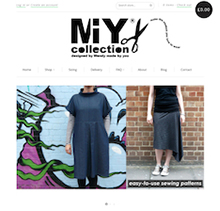The three options are chalk (or wax) in the form of solid lumps or pens and pencils, tailor’s tacks or snipping the fabric. Snips are used in industry and they can be quick and easy, but if you’re still relatively new to sewing my advice is to avoid them – if you make the snips too big, you will weaken the seam allowance and in lightweight fabrics the snip can keep going and cause a tear in wovens or a ladder in knits. Tailor’s tacks are accurate, but they can fall out as you handle your fabric. My favourite method is tailor’s chalk in a lump or pencil, or a marking pen (although I do mark precise pattern markings like buttonholes with lines of tacking in a contrast colour). Use a selection – you’ll find they each work better on different fabrics. I’ve also heard plain old soap works well!
Some people don’t like using the lumps of tailor’s chalk or wax as they get blunt quickly. I find them good for some jobs and you can sharpen them – either buy a special chalk sharpener (yes they do exist – just search online for “tailors chalk sharpener”) or run scissors along either side of the edge (obviously not your fabric scissors!). Chalk is better for firmer, woven fabrics, wax can be better for knits. Recommended brands: Hancock’s, Prymm. Beyond Measure have a great selection of Hancock’s chalk and wax, in lumps as well as pencils and crayons.
For those who don’t like the lumps of chalk and wax you can get various forms of chalk and wax pencils. Some are just like ordinary pencils that you sharpen, but I often find these a bit too hard and can really drag some fabrics. I prefer these style of mechanical chalk pencils that you can buy refill leads for. Wax also comes in a wax crayon form which is really easy to use. You can also get marking pens that look like felt tips that are either water or air dissolvable (beware the air dissolvable ones as the markings disappear quickly!). Recommended brands: Hoechstmass, Sewline.
Chaco liners are used a lot by quilters and are great for precision marking and for use on delicate fabrics that are easily dragged by chalk or wax, eg. silks and lightweight jerseys. The marks do rub off easily though as the marker uses chalk dust. Recommended brands: Clover, Prymm.























Good re *what* to use. But the article still didn’t tell you how to transfer the marks into the fabric. Say there’s a dart. I pin the pattern to the fabric, how the heck do I mark the dart on the fabric??? I have heard make snips in the fabric but that doesn’t outline the whole dart!!! I want the dart (or whatever) outlined on the fabric. How do you do this?
LikeLike
Lift the edge of the pattern to mark the ends of the dart, put a pin through the point and gently lift up the pattern to mark, then remove the pattern and use a ruler to connect the 3 points.
LikeLike
Pingback: Top 20 Beginner Sewing Questions (& Answers!) | Wendy Ward
Pingback: Wednesday Weekly #116 – Helen's Closet
Pingback: Wednesday Weekly #116 – Helen's Closet
Thanks for the mention Wendy. I have been enjoying using the wax and still like a good old tracing wheel and paper now and again!
LikeLike
Good point, although I think in all my life I’ve used that method once 😁 super accurate though!
LikeLike
This article should be titled what to use to transfer pattern markings onto fabric. As a new sewist I’m very interested in the how, but after reading your post I’m still in the dark.
LikeLike
Hi Sharon, I’m not sure exactly what you need to know about the HOW to transfer your pattern markings?
You need to transfer all notches (triangles that appear along the edges of pattern pieces to help with seam matching), dots or circles (which may indicate seam matching or positioning of garment parts such as pockets or belt loops), pleat markings and darts in the position they appear on the pattern onto the wrong side of your fabric. If you’re using chalk or a marking pen/pencil, simply lift up the edge of the paper pattern to mark notches on the edge of your pieces and for markings within the pattern, put a pin through the marking and into the fabric, lift up the pattern so that you can mark where the pin has pierced your fabric. Don’t forget, if your fabric’s folded, you need to mark up both pieces on the wrong side. If you’re using tailor’s tacks, you’ll need to stitch through the pattern. There are plenty of tutorials online about how to work a tailor’s tack, I don’t particularly recommend them, hence I don’t explain how to work them. Hope you’re no longer feeling in the dark!!
LikeLike